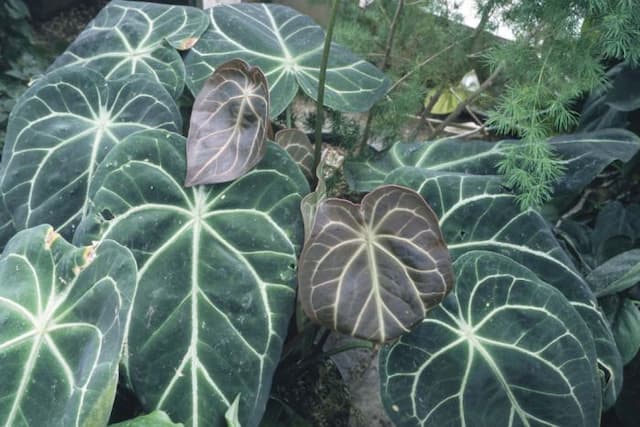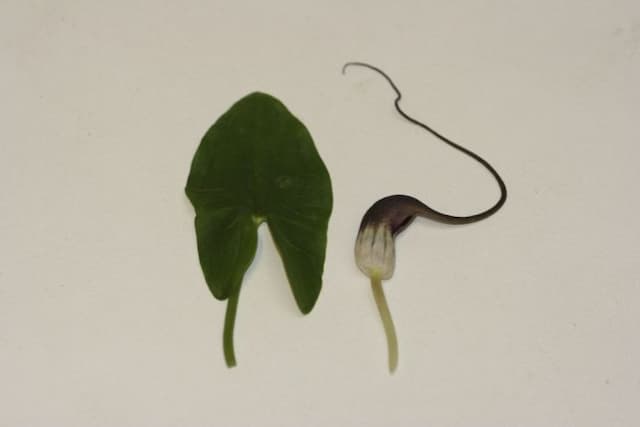Italian Arum Arum italicum

ABOUT
Commonly known as Italian arum, this plant possesses large, arrow-shaped leaves that are often glossy green with unique, pale veins running throughout, which can give them a marbled appearance. As the seasons change, the foliage may shift to include hues of bronze. The leaves emerge in autumn, adorn the plant throughout the winter, and die back as the spring advances. Italian arum blooms with a flower spike, which is not a traditional flower but a bract that looks like a hood. This bract, typically creamy white or pale green in color, encloses a rod-like spadix within that can carry tiny flowers. After flowering, the plant produces clusters of bright, eye-catching berries that are usually vivid red or orange, standing out impressively against the green foliage. However, it should be noted that these berries, while attractive, are toxic if ingested.
About this plant
 Names
NamesFamily
Araceae.
Synonyms
Italian Arum, Italian Lords-and-Ladies, Cuckoo Pint.
Common names
Arum neglectum, Arum modestum, Arum elongatum, Arum pyrenaeum, Arum alpinum, Arum vulgare, Arum venosum
 Toxicity
ToxicityTo humans
The Italian arum is considered toxic due to its content of calcium oxalate crystals. If ingested, any part of the Italian arum can cause a burning sensation in the mouth and throat, swelling of the lips, tongue, and throat, and difficulty in speaking or swallowing. Symptoms can also include gastrointestinal upset, such as nausea, vomiting, and diarrhea. In severe cases, dehydration and electrolyte imbalance may occur due to diarrhea and vomiting. Handling the plant may also cause skin irritation for sensitive individuals. It is important not to ingest any part of this plant and to handle it with care.
To pets
The Italian arum is toxic to pets as well due to its content of insoluble calcium oxalate crystals. If pets ingest any part of the Italian arum, they can experience symptoms such as oral irritation, intense burning, and irritation of the mouth, lips, and tongue, excessive drooling, vomiting, and difficulty swallowing. In severe cases, it could lead to respiratory problems or an obstruction in the airway if swelling is significant. It is crucial to prevent pets from chewing or ingesting any part of this plant.
 Characteristics
CharacteristicsLife cycle
Perennials
Foliage type
Evergreen
Color of leaves
Variegated
Flower color
White
Height
1 foot 6 inches (45.72 cm)
Spread
1 foot (30.48 cm)
Plant type
Herb
Hardiness zones
5
Native area
Mediterranean
Benefits
 General Benefits
General Benefits- Ornamental Value: Arum italicum, commonly known as Italian Arum, provides aesthetic appeal with its attractive foliage and berries, enhancing garden designs.
- Shade Tolerant: It can thrive in shaded areas where other plants may struggle, making it a good choice for woodland gardens or shadowy spots.
- Low Maintenance: Italian Arum requires minimal upkeep once established, making it an easy plant to care for in a variety of garden settings.
- Seasonal Interest: With its changing appearance across seasons—from foliage to flowers to berries—it offers visual interest throughout the year.
- Drought Resistance: Once established, it is relatively drought-tolerant, reducing the need for frequent watering.
- Wildlife Attraction: The berries can attract birds, providing food for wildlife and opportunities for birdwatching.
- Ground Cover: Its ability to spread makes it effective as ground cover, helping to control erosion and suppress weeds.
 Medical Properties
Medical PropertiesThis plant is not used for medical purposes.
 Air-purifying Qualities
Air-purifying QualitiesThis plant is not specifically known for air purifying qualities.
 Other Uses
Other Uses- Arum italicum, commonly known as Italian Arum, can be utilized as an ornamental highlight in shade gardens due to its attractive foliage and berries.
- The large leaves of the Italian Arum are sometimes used in floral arrangements as a unique and exotic greenery addition.
- This plant's ability to grow in dark and often ignored corners makes it a good choice for planting around the base of trees where other plants may struggle.
- Italian Arum tubers were historically used to starch clothes, providing a stiff finish to fabrics.
- The dried stems have been used in traditional crafting for their interesting texture and sturdiness in creating woven goods.
- Due to their interesting shape and color, the spadix and surrounding spathe can be used as natural art subjects for photography and illustration.
- The foliage can serve as unexpected cover for ground-nesting wild animals, like some bird species, due to its dense growth habit.
- Italian Arum sometimes serves as a companion plant, as its presence can indicate soil that is too rich and moist for more sensitive plants.
- In historical times, the plant was used for tanning leather thanks to the tannins present in the leaves and stems.
- Gardeners can use the plant as an education tool to teach about the different reproductive strategies plants use, given its unique flower structure and life cycle.
Interesting Facts
 Feng Shui
Feng ShuiThe Italian Arum is not used in Feng Shui practice.
 Zodiac Sign Compitability
Zodiac Sign CompitabilityThe Italian Arum is not used in astrology practice.
 Plant Symbolism
Plant Symbolism- Undying Love: Arum italicum, commonly known as "Italian Arum," often symbolizes enduring love due to its perennial nature, returning year after year.
- Purity: The plant's striking white spadix inflorescence can symbolize purity and innocence, similar to the symbolism of white flowers in general.
- Resurrection: Italian Arum emerges in spring, a trait that can symbolize rebirth and resurrection, paralleling the cycle of life and renewal.
- Adaptation: Given its ability to grow well in shade, Italian Arum can symbolize the ability to adapt to and thrive in various conditions.
 Water
WaterItalian Arum requires moderate watering, generally about 1 inch per week. Allow the soil to dry out slightly between waterings, and then water thoroughly. Ensure that the plant is never sitting in water as it can lead to root rot. During the growing season, from spring to fall, consistent watering is crucial. In winter, reduce watering as the plant enters dormancy, giving only enough to prevent the soil from completely drying out, which may equate to around half a gallon every two weeks depending on the size of the plant.
 Light
LightItalian Arum thrives in partial shade to full shade conditions. The best spot for it would be in dappled sunlight under tall trees or in a shady corner of a garden where it can receive indirect light. Direct sunlight can scorch the leaves, so it’s important to ensure the plant is shielded from strong afternoon sun.
 Temperature
TemperatureItalian Arum prefers temperate climates and does well in temperatures ranging between 50°F and 80°F. It can tolerate a minimum temperature close to freezing for a short period, but prolonged exposure can be harmful. The ideal temperature range for growth and flowering is between 65°F and 75°F.
 Pruning
PruningPruning Italian Arum mainly involves removing dead or yellowing leaves to maintain plant health and aesthetic appeal. Pruning is best done in late fall or early winter after the leaves have died back. This annual pruning helps to prevent disease and allows for fresh growth in the spring.
 Cleaning
CleaningAs needed
 Soil
SoilItalian Arum prefers a well-draining soil mix rich in organic matter with a soil pH range of 5.5 to 6.5. A mix of garden soil, peat, and perlite can create optimal conditions for its growth.
 Repotting
RepottingItalian Arum should be repotted every 2-3 years or when it becomes root-bound. This will provide fresh nutrients and room for continued growth.
 Humidity & Misting
Humidity & MistingItalian Arum thrives in moderate to high humidity levels, ideally between 40-60%. It benefits from a humid environment but can tolerate standard indoor levels.
 Suitable locations
Suitable locationsIndoor
Use well-draining soil and place Italian Arum in bright, indirect light indoors.
Outdoor
Plant Italian Arum in partial shade and moist soil outdoors.
Hardiness zone
5-9 USDA
 Life cycle
Life cycleItalian arum typically begins its life cycle as a dormant underground corm, which germinates in late fall to early winter when temperatures start to cool. The plant then produces a lush, green foliage of arrow-shaped leaves that persist through the winter and spring, often with attractive silver-white veining. During spring, Italian arum sends up a flower spike, or spadix, surrounded by a hood-like bract called a spathe, which can range in color from green to white or even purple. After pollination, typically by flies attracted to the spadix's heat and odor, the flowers develop into a spike of orange-red berries by summer. As temperatures rise, the foliage dies back, and the plant enters a period of dormancy through the hottest part of the year, with the corm surviving underground. In the subsequent fall, the cycle begins anew with the emergence of foliage, restarting the perennial life cycle of the Italian arum.
 Propogation
PropogationPropogation time
Late summer
Propogation: The Italian Arum is typically propagated through division of tubers, which is best done in the fall after the foliage has died back. To propagate by division, carefully lift the tubers from the soil and gently separate them, ensuring each section has at least one growth point. Replant the divisions immediately at a depth of 4 to 5 inches (about 10 to 12.7 centimeters), spacing them about 6 to 12 inches (15 to 30 centimeters) apart in well-draining soil. This method allows the plant to establish during the cool and moist fall and winter months, preparing it for growth in the spring.









